Comprehensive Business Environment Analysis and Strategic Impact
VerifiedAdded on 2024/06/05
|20
|4946
|257
Report
AI Summary
This report provides a comprehensive analysis of the business environment, covering various aspects such as organizational types in the public and private sectors, different business structures, and the impact of the local, national, and global economic environment on businesses like Tesco. It also explains the importance of accounting for business success, describes the functions of the HR department, and outlines key features of employment legislation. Furthermore, the report interprets information from a profit and loss account, analyzes team roles, and provides notes on team development stages, motivation theories, and leadership styles. Finally, it discusses the impact of customer service and the benefits of customer profiling on business success. This document is available on Desklib, a platform offering a wide range of study tools and resources for students.
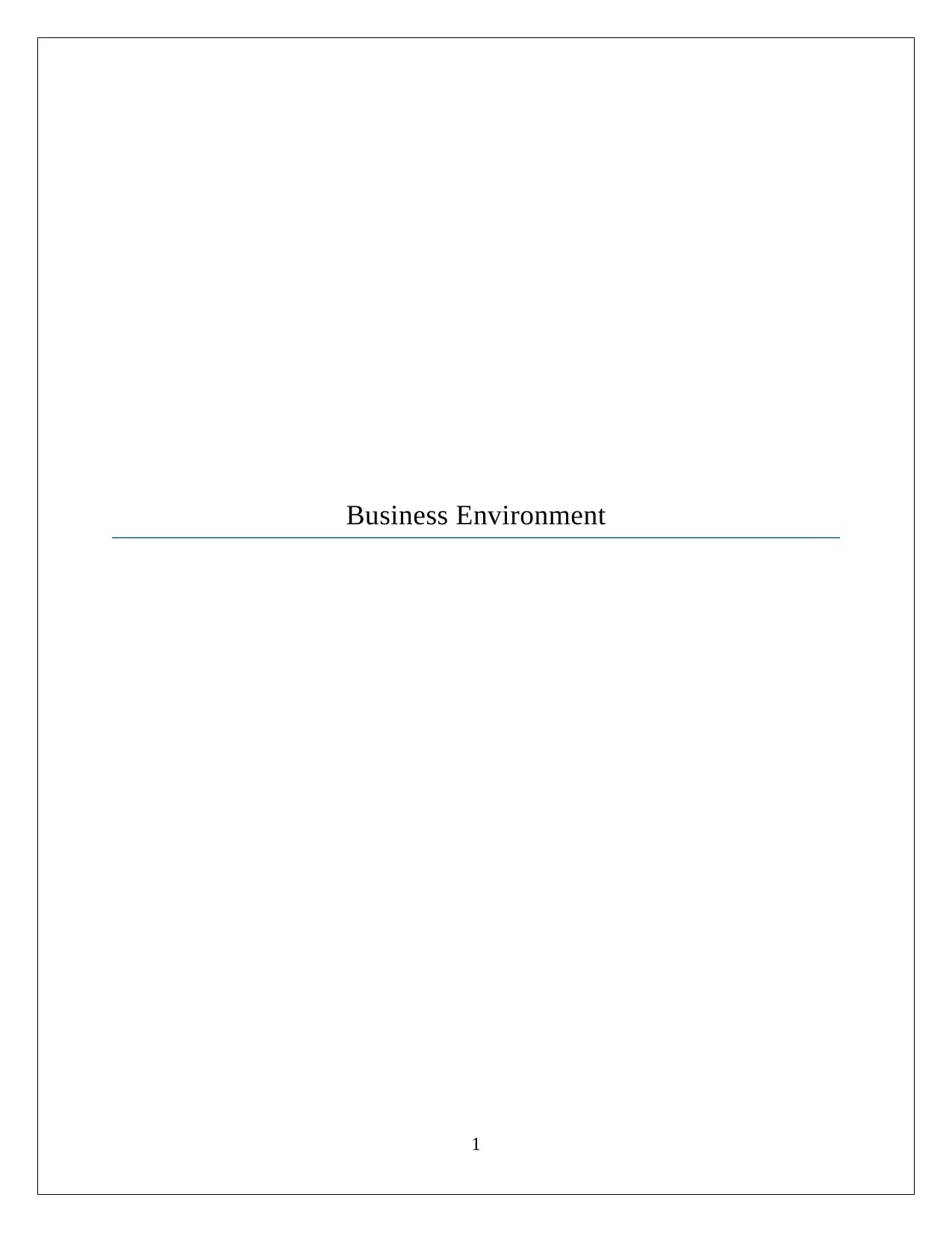
Business Environment
1
1
Paraphrase This Document
Need a fresh take? Get an instant paraphrase of this document with our AI Paraphraser
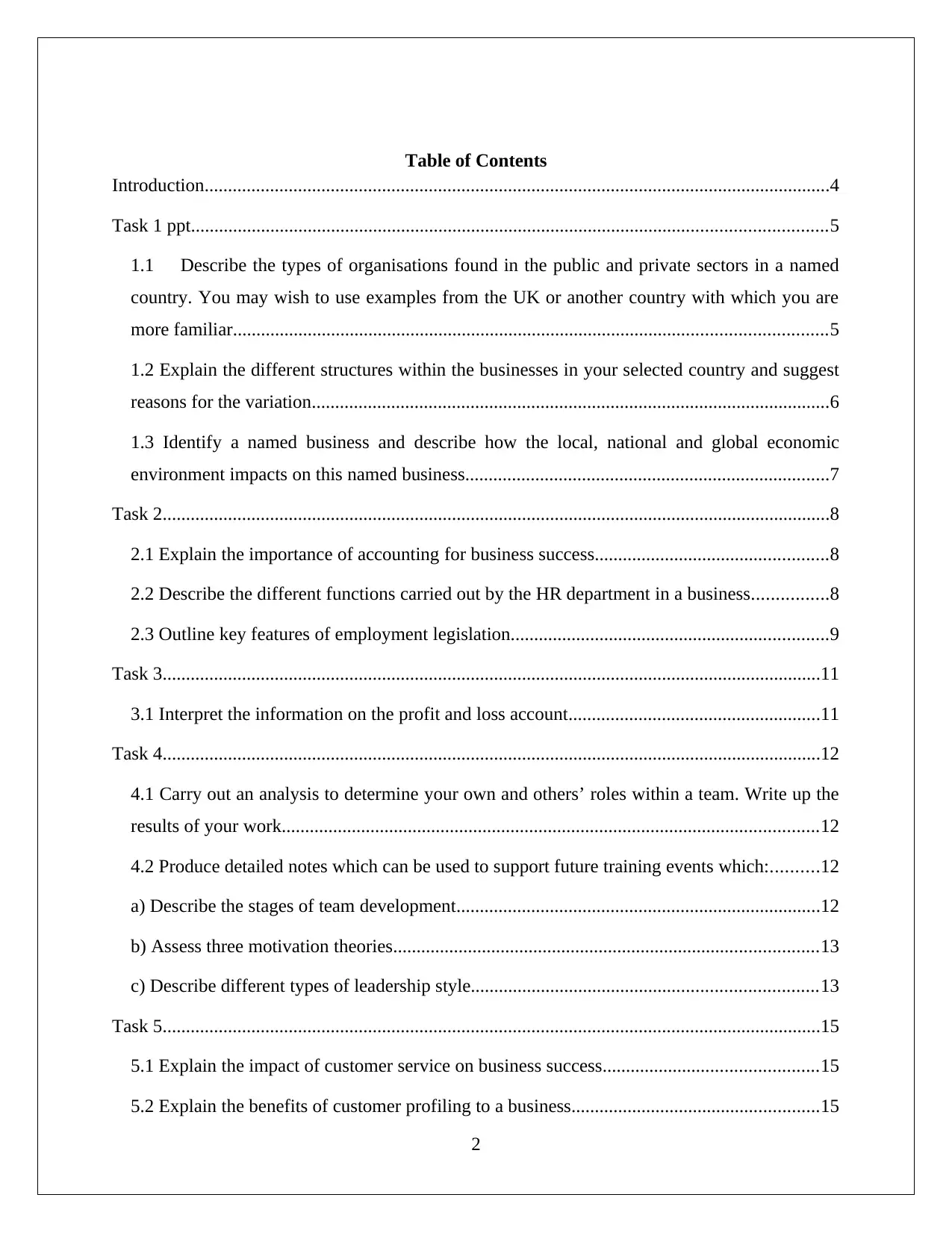
Table of Contents
Introduction......................................................................................................................................4
Task 1 ppt........................................................................................................................................5
1.1 Describe the types of organisations found in the public and private sectors in a named
country. You may wish to use examples from the UK or another country with which you are
more familiar...............................................................................................................................5
1.2 Explain the different structures within the businesses in your selected country and suggest
reasons for the variation...............................................................................................................6
1.3 Identify a named business and describe how the local, national and global economic
environment impacts on this named business..............................................................................7
Task 2...............................................................................................................................................8
2.1 Explain the importance of accounting for business success..................................................8
2.2 Describe the different functions carried out by the HR department in a business................8
2.3 Outline key features of employment legislation....................................................................9
Task 3.............................................................................................................................................11
3.1 Interpret the information on the profit and loss account......................................................11
Task 4.............................................................................................................................................12
4.1 Carry out an analysis to determine your own and others’ roles within a team. Write up the
results of your work...................................................................................................................12
4.2 Produce detailed notes which can be used to support future training events which:..........12
a) Describe the stages of team development..............................................................................12
b) Assess three motivation theories...........................................................................................13
c) Describe different types of leadership style..........................................................................13
Task 5.............................................................................................................................................15
5.1 Explain the impact of customer service on business success..............................................15
5.2 Explain the benefits of customer profiling to a business.....................................................15
2
Introduction......................................................................................................................................4
Task 1 ppt........................................................................................................................................5
1.1 Describe the types of organisations found in the public and private sectors in a named
country. You may wish to use examples from the UK or another country with which you are
more familiar...............................................................................................................................5
1.2 Explain the different structures within the businesses in your selected country and suggest
reasons for the variation...............................................................................................................6
1.3 Identify a named business and describe how the local, national and global economic
environment impacts on this named business..............................................................................7
Task 2...............................................................................................................................................8
2.1 Explain the importance of accounting for business success..................................................8
2.2 Describe the different functions carried out by the HR department in a business................8
2.3 Outline key features of employment legislation....................................................................9
Task 3.............................................................................................................................................11
3.1 Interpret the information on the profit and loss account......................................................11
Task 4.............................................................................................................................................12
4.1 Carry out an analysis to determine your own and others’ roles within a team. Write up the
results of your work...................................................................................................................12
4.2 Produce detailed notes which can be used to support future training events which:..........12
a) Describe the stages of team development..............................................................................12
b) Assess three motivation theories...........................................................................................13
c) Describe different types of leadership style..........................................................................13
Task 5.............................................................................................................................................15
5.1 Explain the impact of customer service on business success..............................................15
5.2 Explain the benefits of customer profiling to a business.....................................................15
2
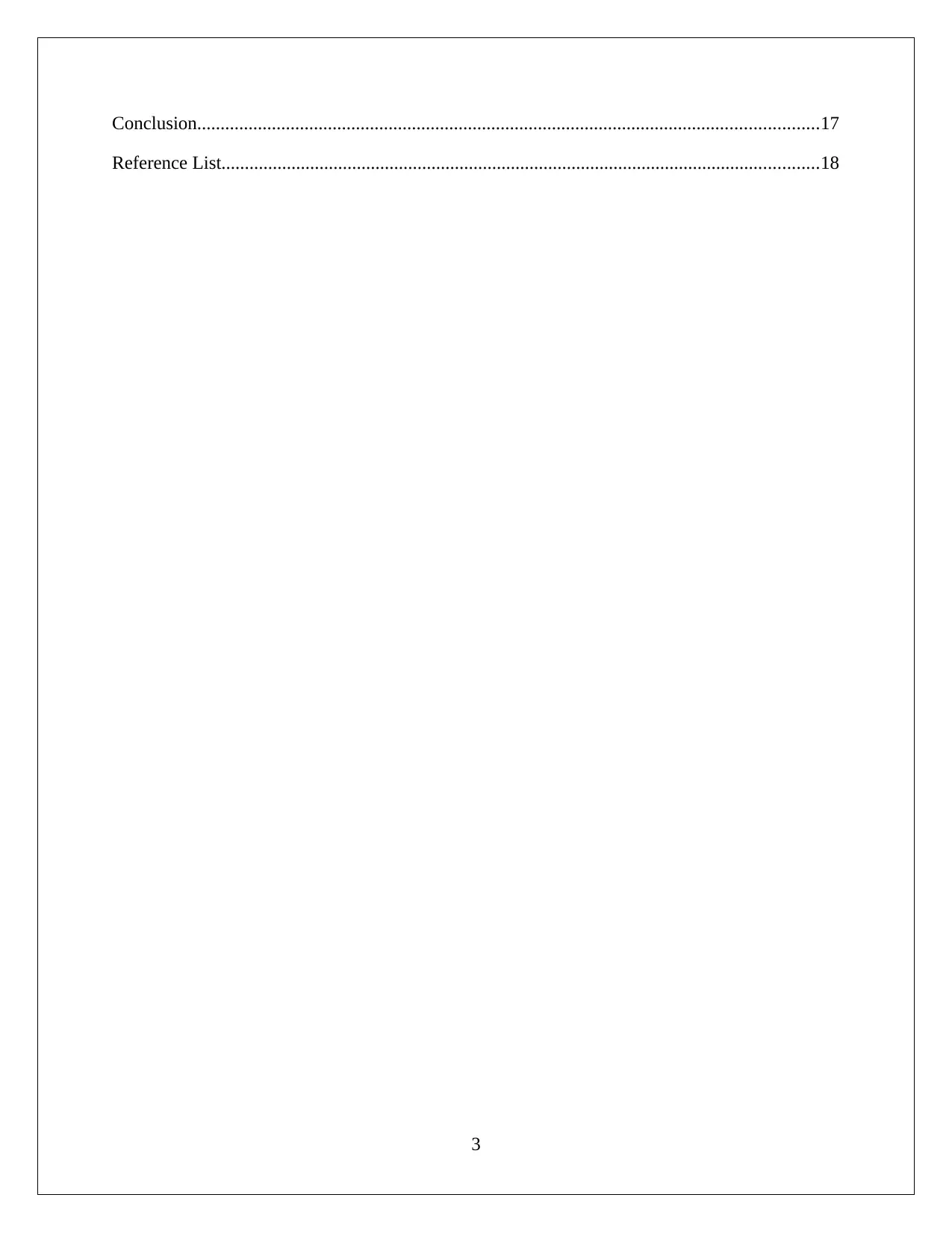
Conclusion.....................................................................................................................................17
Reference List................................................................................................................................18
3
Reference List................................................................................................................................18
3
⊘ This is a preview!⊘
Do you want full access?
Subscribe today to unlock all pages.

Trusted by 1+ million students worldwide
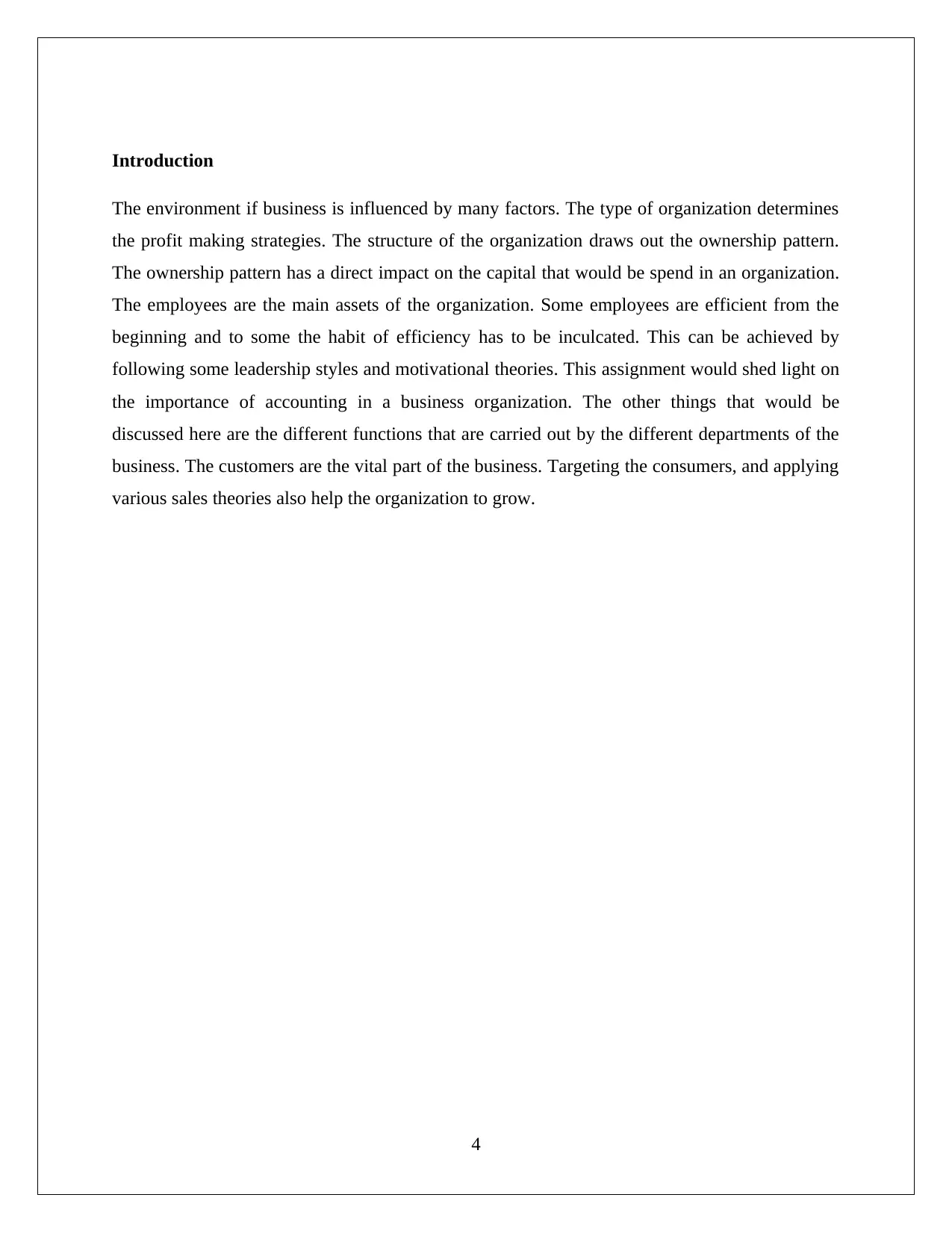
Introduction
The environment if business is influenced by many factors. The type of organization determines
the profit making strategies. The structure of the organization draws out the ownership pattern.
The ownership pattern has a direct impact on the capital that would be spend in an organization.
The employees are the main assets of the organization. Some employees are efficient from the
beginning and to some the habit of efficiency has to be inculcated. This can be achieved by
following some leadership styles and motivational theories. This assignment would shed light on
the importance of accounting in a business organization. The other things that would be
discussed here are the different functions that are carried out by the different departments of the
business. The customers are the vital part of the business. Targeting the consumers, and applying
various sales theories also help the organization to grow.
4
The environment if business is influenced by many factors. The type of organization determines
the profit making strategies. The structure of the organization draws out the ownership pattern.
The ownership pattern has a direct impact on the capital that would be spend in an organization.
The employees are the main assets of the organization. Some employees are efficient from the
beginning and to some the habit of efficiency has to be inculcated. This can be achieved by
following some leadership styles and motivational theories. This assignment would shed light on
the importance of accounting in a business organization. The other things that would be
discussed here are the different functions that are carried out by the different departments of the
business. The customers are the vital part of the business. Targeting the consumers, and applying
various sales theories also help the organization to grow.
4
Paraphrase This Document
Need a fresh take? Get an instant paraphrase of this document with our AI Paraphraser
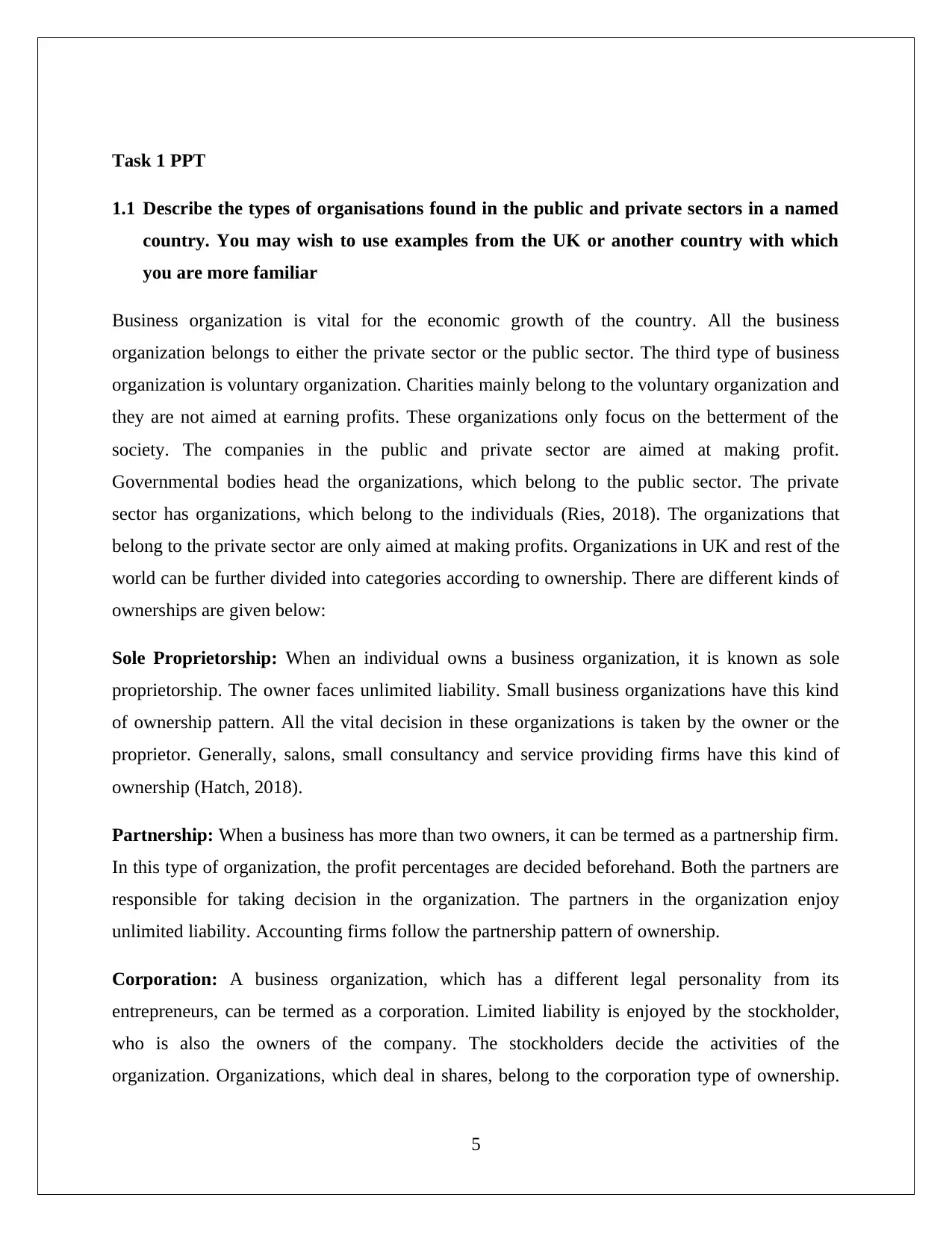
Task 1 PPT
1.1 Describe the types of organisations found in the public and private sectors in a named
country. You may wish to use examples from the UK or another country with which
you are more familiar
Business organization is vital for the economic growth of the country. All the business
organization belongs to either the private sector or the public sector. The third type of business
organization is voluntary organization. Charities mainly belong to the voluntary organization and
they are not aimed at earning profits. These organizations only focus on the betterment of the
society. The companies in the public and private sector are aimed at making profit.
Governmental bodies head the organizations, which belong to the public sector. The private
sector has organizations, which belong to the individuals (Ries, 2018). The organizations that
belong to the private sector are only aimed at making profits. Organizations in UK and rest of the
world can be further divided into categories according to ownership. There are different kinds of
ownerships are given below:
Sole Proprietorship: When an individual owns a business organization, it is known as sole
proprietorship. The owner faces unlimited liability. Small business organizations have this kind
of ownership pattern. All the vital decision in these organizations is taken by the owner or the
proprietor. Generally, salons, small consultancy and service providing firms have this kind of
ownership (Hatch, 2018).
Partnership: When a business has more than two owners, it can be termed as a partnership firm.
In this type of organization, the profit percentages are decided beforehand. Both the partners are
responsible for taking decision in the organization. The partners in the organization enjoy
unlimited liability. Accounting firms follow the partnership pattern of ownership.
Corporation: A business organization, which has a different legal personality from its
entrepreneurs, can be termed as a corporation. Limited liability is enjoyed by the stockholder,
who is also the owners of the company. The stockholders decide the activities of the
organization. Organizations, which deal in shares, belong to the corporation type of ownership.
5
1.1 Describe the types of organisations found in the public and private sectors in a named
country. You may wish to use examples from the UK or another country with which
you are more familiar
Business organization is vital for the economic growth of the country. All the business
organization belongs to either the private sector or the public sector. The third type of business
organization is voluntary organization. Charities mainly belong to the voluntary organization and
they are not aimed at earning profits. These organizations only focus on the betterment of the
society. The companies in the public and private sector are aimed at making profit.
Governmental bodies head the organizations, which belong to the public sector. The private
sector has organizations, which belong to the individuals (Ries, 2018). The organizations that
belong to the private sector are only aimed at making profits. Organizations in UK and rest of the
world can be further divided into categories according to ownership. There are different kinds of
ownerships are given below:
Sole Proprietorship: When an individual owns a business organization, it is known as sole
proprietorship. The owner faces unlimited liability. Small business organizations have this kind
of ownership pattern. All the vital decision in these organizations is taken by the owner or the
proprietor. Generally, salons, small consultancy and service providing firms have this kind of
ownership (Hatch, 2018).
Partnership: When a business has more than two owners, it can be termed as a partnership firm.
In this type of organization, the profit percentages are decided beforehand. Both the partners are
responsible for taking decision in the organization. The partners in the organization enjoy
unlimited liability. Accounting firms follow the partnership pattern of ownership.
Corporation: A business organization, which has a different legal personality from its
entrepreneurs, can be termed as a corporation. Limited liability is enjoyed by the stockholder,
who is also the owners of the company. The stockholders decide the activities of the
organization. Organizations, which deal in shares, belong to the corporation type of ownership.
5
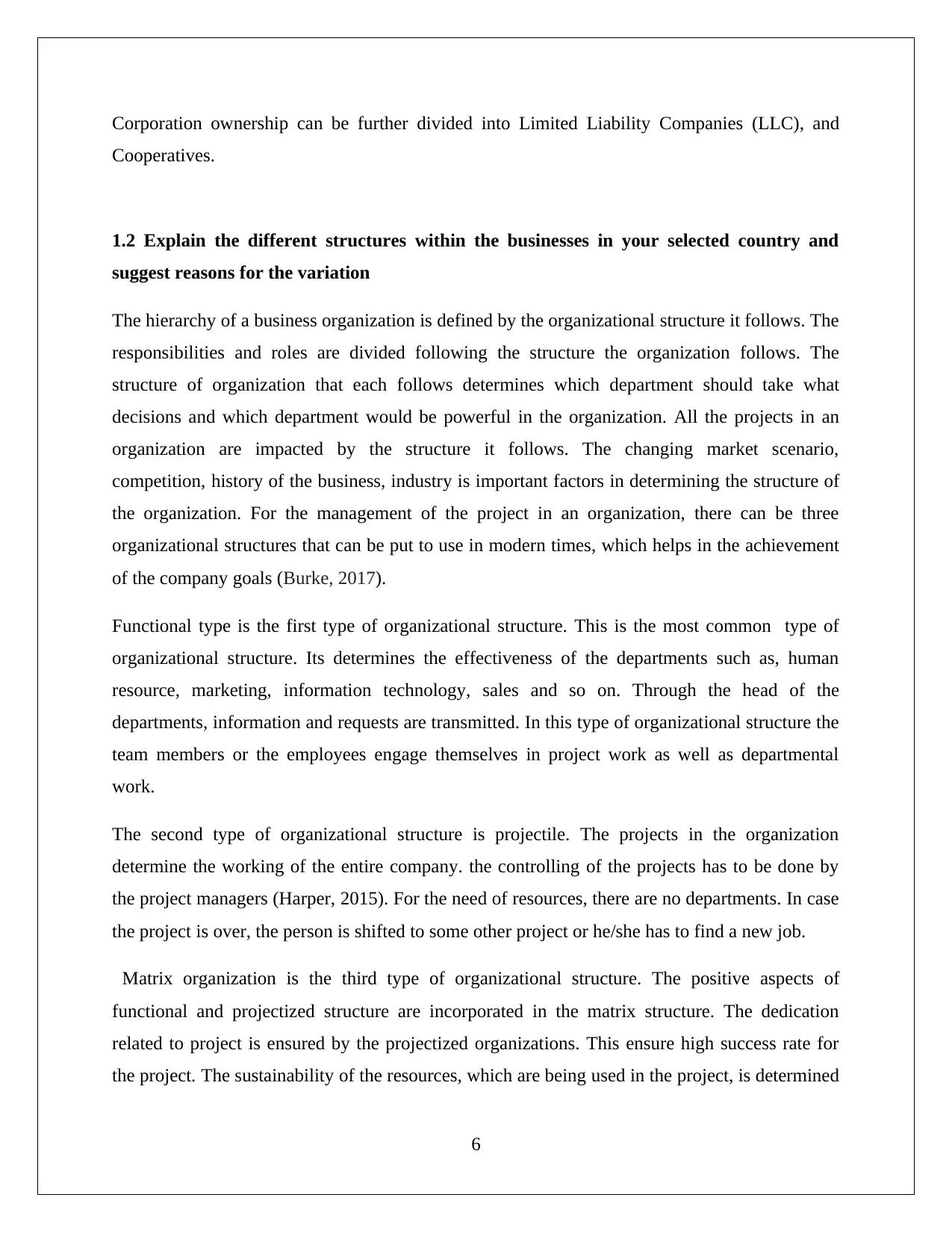
Corporation ownership can be further divided into Limited Liability Companies (LLC), and
Cooperatives.
1.2 Explain the different structures within the businesses in your selected country and
suggest reasons for the variation
The hierarchy of a business organization is defined by the organizational structure it follows. The
responsibilities and roles are divided following the structure the organization follows. The
structure of organization that each follows determines which department should take what
decisions and which department would be powerful in the organization. All the projects in an
organization are impacted by the structure it follows. The changing market scenario,
competition, history of the business, industry is important factors in determining the structure of
the organization. For the management of the project in an organization, there can be three
organizational structures that can be put to use in modern times, which helps in the achievement
of the company goals (Burke, 2017).
Functional type is the first type of organizational structure. This is the most common type of
organizational structure. Its determines the effectiveness of the departments such as, human
resource, marketing, information technology, sales and so on. Through the head of the
departments, information and requests are transmitted. In this type of organizational structure the
team members or the employees engage themselves in project work as well as departmental
work.
The second type of organizational structure is projectile. The projects in the organization
determine the working of the entire company. the controlling of the projects has to be done by
the project managers (Harper, 2015). For the need of resources, there are no departments. In case
the project is over, the person is shifted to some other project or he/she has to find a new job.
Matrix organization is the third type of organizational structure. The positive aspects of
functional and projectized structure are incorporated in the matrix structure. The dedication
related to project is ensured by the projectized organizations. This ensure high success rate for
the project. The sustainability of the resources, which are being used in the project, is determined
6
Cooperatives.
1.2 Explain the different structures within the businesses in your selected country and
suggest reasons for the variation
The hierarchy of a business organization is defined by the organizational structure it follows. The
responsibilities and roles are divided following the structure the organization follows. The
structure of organization that each follows determines which department should take what
decisions and which department would be powerful in the organization. All the projects in an
organization are impacted by the structure it follows. The changing market scenario,
competition, history of the business, industry is important factors in determining the structure of
the organization. For the management of the project in an organization, there can be three
organizational structures that can be put to use in modern times, which helps in the achievement
of the company goals (Burke, 2017).
Functional type is the first type of organizational structure. This is the most common type of
organizational structure. Its determines the effectiveness of the departments such as, human
resource, marketing, information technology, sales and so on. Through the head of the
departments, information and requests are transmitted. In this type of organizational structure the
team members or the employees engage themselves in project work as well as departmental
work.
The second type of organizational structure is projectile. The projects in the organization
determine the working of the entire company. the controlling of the projects has to be done by
the project managers (Harper, 2015). For the need of resources, there are no departments. In case
the project is over, the person is shifted to some other project or he/she has to find a new job.
Matrix organization is the third type of organizational structure. The positive aspects of
functional and projectized structure are incorporated in the matrix structure. The dedication
related to project is ensured by the projectized organizations. This ensure high success rate for
the project. The sustainability of the resources, which are being used in the project, is determined
6
⊘ This is a preview!⊘
Do you want full access?
Subscribe today to unlock all pages.

Trusted by 1+ million students worldwide
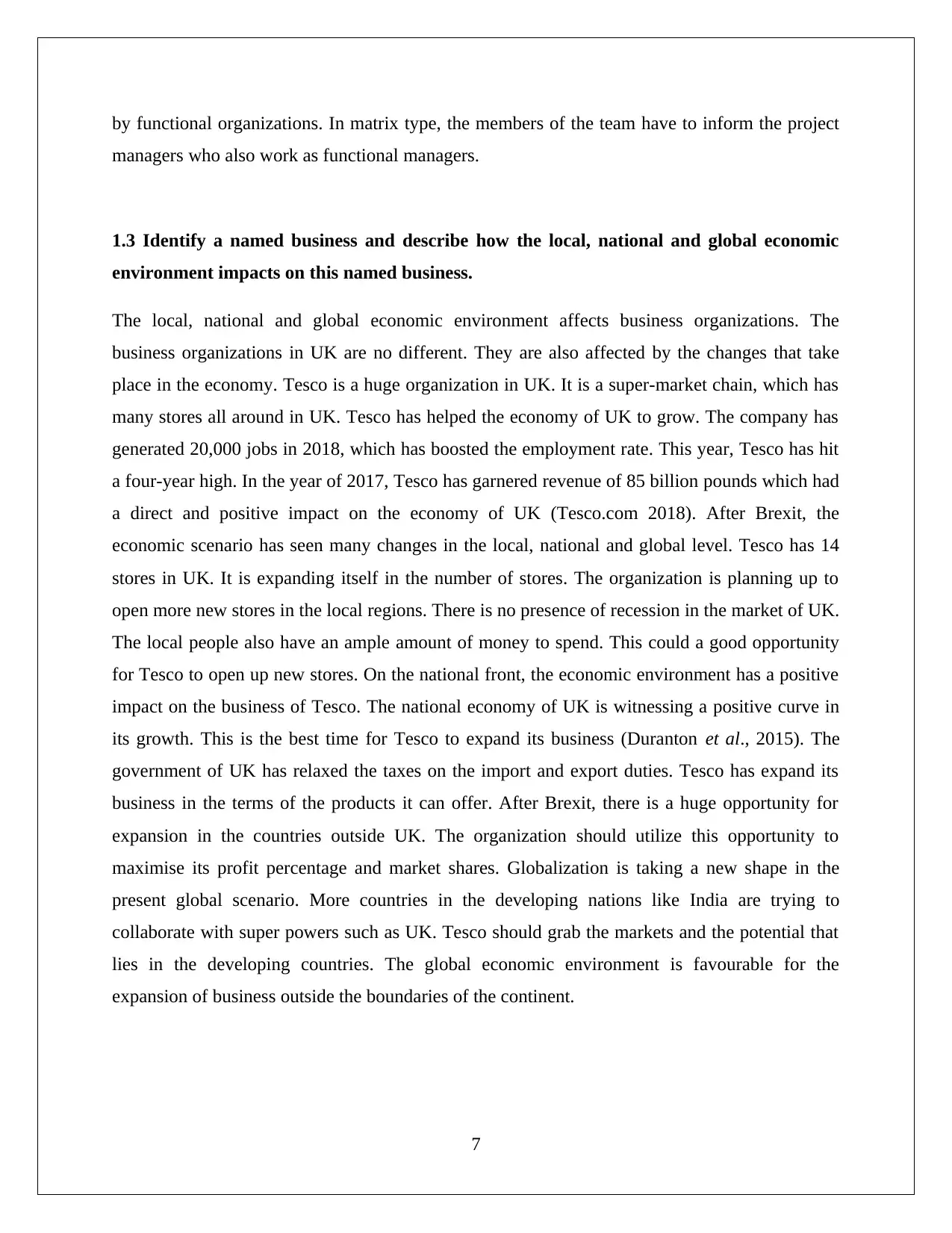
by functional organizations. In matrix type, the members of the team have to inform the project
managers who also work as functional managers.
1.3 Identify a named business and describe how the local, national and global economic
environment impacts on this named business.
The local, national and global economic environment affects business organizations. The
business organizations in UK are no different. They are also affected by the changes that take
place in the economy. Tesco is a huge organization in UK. It is a super-market chain, which has
many stores all around in UK. Tesco has helped the economy of UK to grow. The company has
generated 20,000 jobs in 2018, which has boosted the employment rate. This year, Tesco has hit
a four-year high. In the year of 2017, Tesco has garnered revenue of 85 billion pounds which had
a direct and positive impact on the economy of UK (Tesco.com 2018). After Brexit, the
economic scenario has seen many changes in the local, national and global level. Tesco has 14
stores in UK. It is expanding itself in the number of stores. The organization is planning up to
open more new stores in the local regions. There is no presence of recession in the market of UK.
The local people also have an ample amount of money to spend. This could a good opportunity
for Tesco to open up new stores. On the national front, the economic environment has a positive
impact on the business of Tesco. The national economy of UK is witnessing a positive curve in
its growth. This is the best time for Tesco to expand its business (Duranton et al., 2015). The
government of UK has relaxed the taxes on the import and export duties. Tesco has expand its
business in the terms of the products it can offer. After Brexit, there is a huge opportunity for
expansion in the countries outside UK. The organization should utilize this opportunity to
maximise its profit percentage and market shares. Globalization is taking a new shape in the
present global scenario. More countries in the developing nations like India are trying to
collaborate with super powers such as UK. Tesco should grab the markets and the potential that
lies in the developing countries. The global economic environment is favourable for the
expansion of business outside the boundaries of the continent.
7
managers who also work as functional managers.
1.3 Identify a named business and describe how the local, national and global economic
environment impacts on this named business.
The local, national and global economic environment affects business organizations. The
business organizations in UK are no different. They are also affected by the changes that take
place in the economy. Tesco is a huge organization in UK. It is a super-market chain, which has
many stores all around in UK. Tesco has helped the economy of UK to grow. The company has
generated 20,000 jobs in 2018, which has boosted the employment rate. This year, Tesco has hit
a four-year high. In the year of 2017, Tesco has garnered revenue of 85 billion pounds which had
a direct and positive impact on the economy of UK (Tesco.com 2018). After Brexit, the
economic scenario has seen many changes in the local, national and global level. Tesco has 14
stores in UK. It is expanding itself in the number of stores. The organization is planning up to
open more new stores in the local regions. There is no presence of recession in the market of UK.
The local people also have an ample amount of money to spend. This could a good opportunity
for Tesco to open up new stores. On the national front, the economic environment has a positive
impact on the business of Tesco. The national economy of UK is witnessing a positive curve in
its growth. This is the best time for Tesco to expand its business (Duranton et al., 2015). The
government of UK has relaxed the taxes on the import and export duties. Tesco has expand its
business in the terms of the products it can offer. After Brexit, there is a huge opportunity for
expansion in the countries outside UK. The organization should utilize this opportunity to
maximise its profit percentage and market shares. Globalization is taking a new shape in the
present global scenario. More countries in the developing nations like India are trying to
collaborate with super powers such as UK. Tesco should grab the markets and the potential that
lies in the developing countries. The global economic environment is favourable for the
expansion of business outside the boundaries of the continent.
7
Paraphrase This Document
Need a fresh take? Get an instant paraphrase of this document with our AI Paraphraser
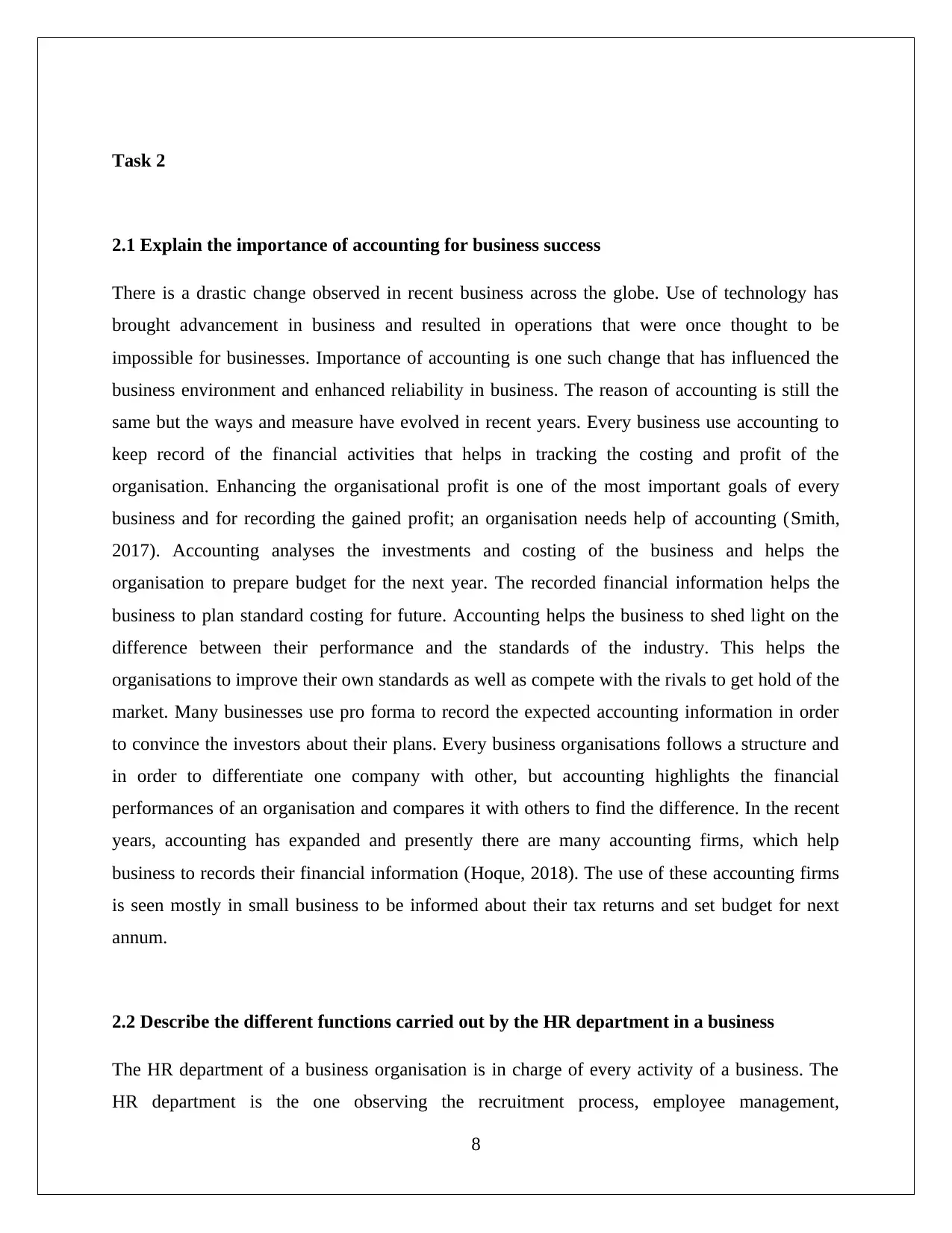
Task 2
2.1 Explain the importance of accounting for business success
There is a drastic change observed in recent business across the globe. Use of technology has
brought advancement in business and resulted in operations that were once thought to be
impossible for businesses. Importance of accounting is one such change that has influenced the
business environment and enhanced reliability in business. The reason of accounting is still the
same but the ways and measure have evolved in recent years. Every business use accounting to
keep record of the financial activities that helps in tracking the costing and profit of the
organisation. Enhancing the organisational profit is one of the most important goals of every
business and for recording the gained profit; an organisation needs help of accounting (Smith,
2017). Accounting analyses the investments and costing of the business and helps the
organisation to prepare budget for the next year. The recorded financial information helps the
business to plan standard costing for future. Accounting helps the business to shed light on the
difference between their performance and the standards of the industry. This helps the
organisations to improve their own standards as well as compete with the rivals to get hold of the
market. Many businesses use pro forma to record the expected accounting information in order
to convince the investors about their plans. Every business organisations follows a structure and
in order to differentiate one company with other, but accounting highlights the financial
performances of an organisation and compares it with others to find the difference. In the recent
years, accounting has expanded and presently there are many accounting firms, which help
business to records their financial information (Hoque, 2018). The use of these accounting firms
is seen mostly in small business to be informed about their tax returns and set budget for next
annum.
2.2 Describe the different functions carried out by the HR department in a business
The HR department of a business organisation is in charge of every activity of a business. The
HR department is the one observing the recruitment process, employee management,
8
2.1 Explain the importance of accounting for business success
There is a drastic change observed in recent business across the globe. Use of technology has
brought advancement in business and resulted in operations that were once thought to be
impossible for businesses. Importance of accounting is one such change that has influenced the
business environment and enhanced reliability in business. The reason of accounting is still the
same but the ways and measure have evolved in recent years. Every business use accounting to
keep record of the financial activities that helps in tracking the costing and profit of the
organisation. Enhancing the organisational profit is one of the most important goals of every
business and for recording the gained profit; an organisation needs help of accounting (Smith,
2017). Accounting analyses the investments and costing of the business and helps the
organisation to prepare budget for the next year. The recorded financial information helps the
business to plan standard costing for future. Accounting helps the business to shed light on the
difference between their performance and the standards of the industry. This helps the
organisations to improve their own standards as well as compete with the rivals to get hold of the
market. Many businesses use pro forma to record the expected accounting information in order
to convince the investors about their plans. Every business organisations follows a structure and
in order to differentiate one company with other, but accounting highlights the financial
performances of an organisation and compares it with others to find the difference. In the recent
years, accounting has expanded and presently there are many accounting firms, which help
business to records their financial information (Hoque, 2018). The use of these accounting firms
is seen mostly in small business to be informed about their tax returns and set budget for next
annum.
2.2 Describe the different functions carried out by the HR department in a business
The HR department of a business organisation is in charge of every activity of a business. The
HR department is the one observing the recruitment process, employee management,
8
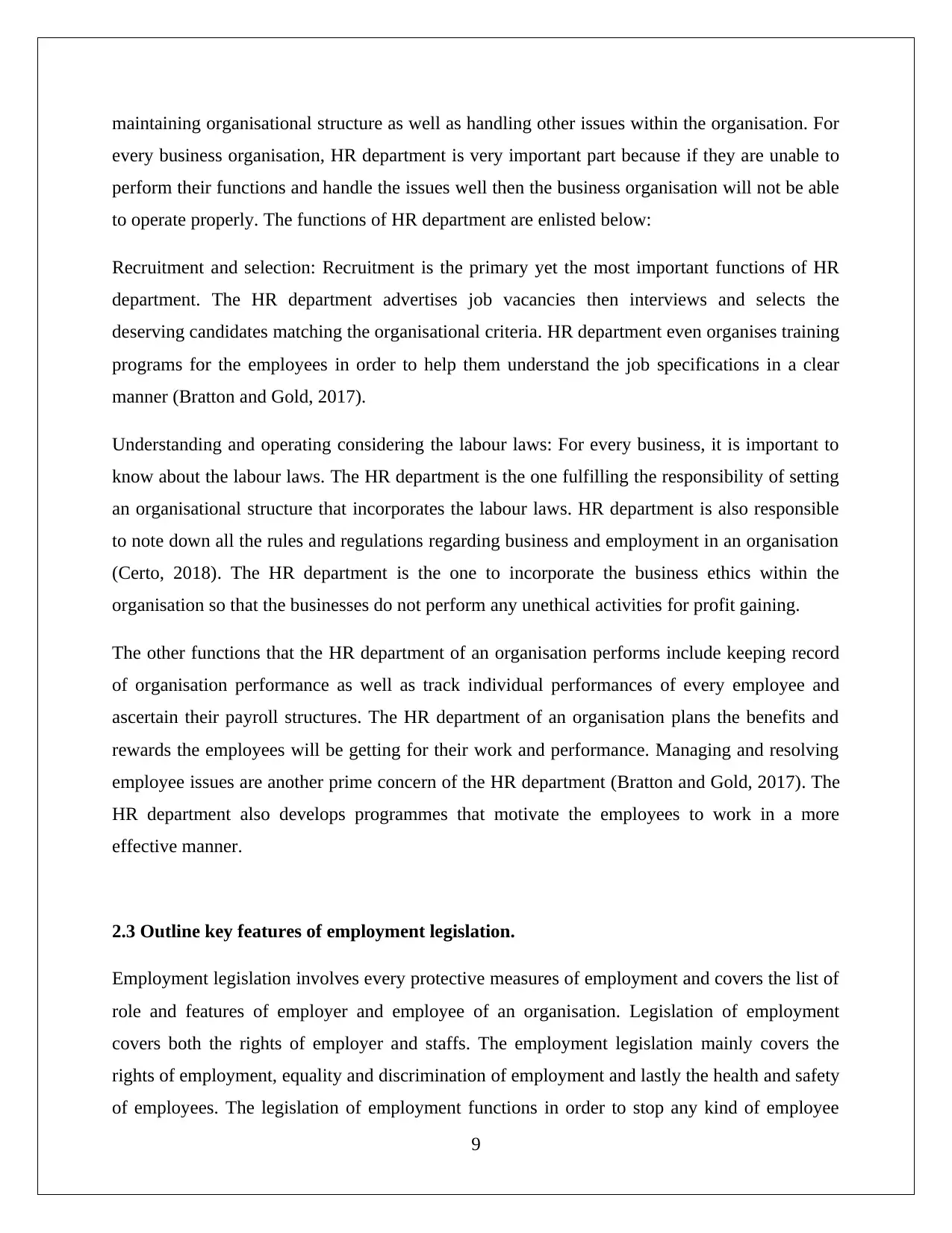
maintaining organisational structure as well as handling other issues within the organisation. For
every business organisation, HR department is very important part because if they are unable to
perform their functions and handle the issues well then the business organisation will not be able
to operate properly. The functions of HR department are enlisted below:
Recruitment and selection: Recruitment is the primary yet the most important functions of HR
department. The HR department advertises job vacancies then interviews and selects the
deserving candidates matching the organisational criteria. HR department even organises training
programs for the employees in order to help them understand the job specifications in a clear
manner (Bratton and Gold, 2017).
Understanding and operating considering the labour laws: For every business, it is important to
know about the labour laws. The HR department is the one fulfilling the responsibility of setting
an organisational structure that incorporates the labour laws. HR department is also responsible
to note down all the rules and regulations regarding business and employment in an organisation
(Certo, 2018). The HR department is the one to incorporate the business ethics within the
organisation so that the businesses do not perform any unethical activities for profit gaining.
The other functions that the HR department of an organisation performs include keeping record
of organisation performance as well as track individual performances of every employee and
ascertain their payroll structures. The HR department of an organisation plans the benefits and
rewards the employees will be getting for their work and performance. Managing and resolving
employee issues are another prime concern of the HR department (Bratton and Gold, 2017). The
HR department also develops programmes that motivate the employees to work in a more
effective manner.
2.3 Outline key features of employment legislation.
Employment legislation involves every protective measures of employment and covers the list of
role and features of employer and employee of an organisation. Legislation of employment
covers both the rights of employer and staffs. The employment legislation mainly covers the
rights of employment, equality and discrimination of employment and lastly the health and safety
of employees. The legislation of employment functions in order to stop any kind of employee
9
every business organisation, HR department is very important part because if they are unable to
perform their functions and handle the issues well then the business organisation will not be able
to operate properly. The functions of HR department are enlisted below:
Recruitment and selection: Recruitment is the primary yet the most important functions of HR
department. The HR department advertises job vacancies then interviews and selects the
deserving candidates matching the organisational criteria. HR department even organises training
programs for the employees in order to help them understand the job specifications in a clear
manner (Bratton and Gold, 2017).
Understanding and operating considering the labour laws: For every business, it is important to
know about the labour laws. The HR department is the one fulfilling the responsibility of setting
an organisational structure that incorporates the labour laws. HR department is also responsible
to note down all the rules and regulations regarding business and employment in an organisation
(Certo, 2018). The HR department is the one to incorporate the business ethics within the
organisation so that the businesses do not perform any unethical activities for profit gaining.
The other functions that the HR department of an organisation performs include keeping record
of organisation performance as well as track individual performances of every employee and
ascertain their payroll structures. The HR department of an organisation plans the benefits and
rewards the employees will be getting for their work and performance. Managing and resolving
employee issues are another prime concern of the HR department (Bratton and Gold, 2017). The
HR department also develops programmes that motivate the employees to work in a more
effective manner.
2.3 Outline key features of employment legislation.
Employment legislation involves every protective measures of employment and covers the list of
role and features of employer and employee of an organisation. Legislation of employment
covers both the rights of employer and staffs. The employment legislation mainly covers the
rights of employment, equality and discrimination of employment and lastly the health and safety
of employees. The legislation of employment functions in order to stop any kind of employee
9
⊘ This is a preview!⊘
Do you want full access?
Subscribe today to unlock all pages.

Trusted by 1+ million students worldwide
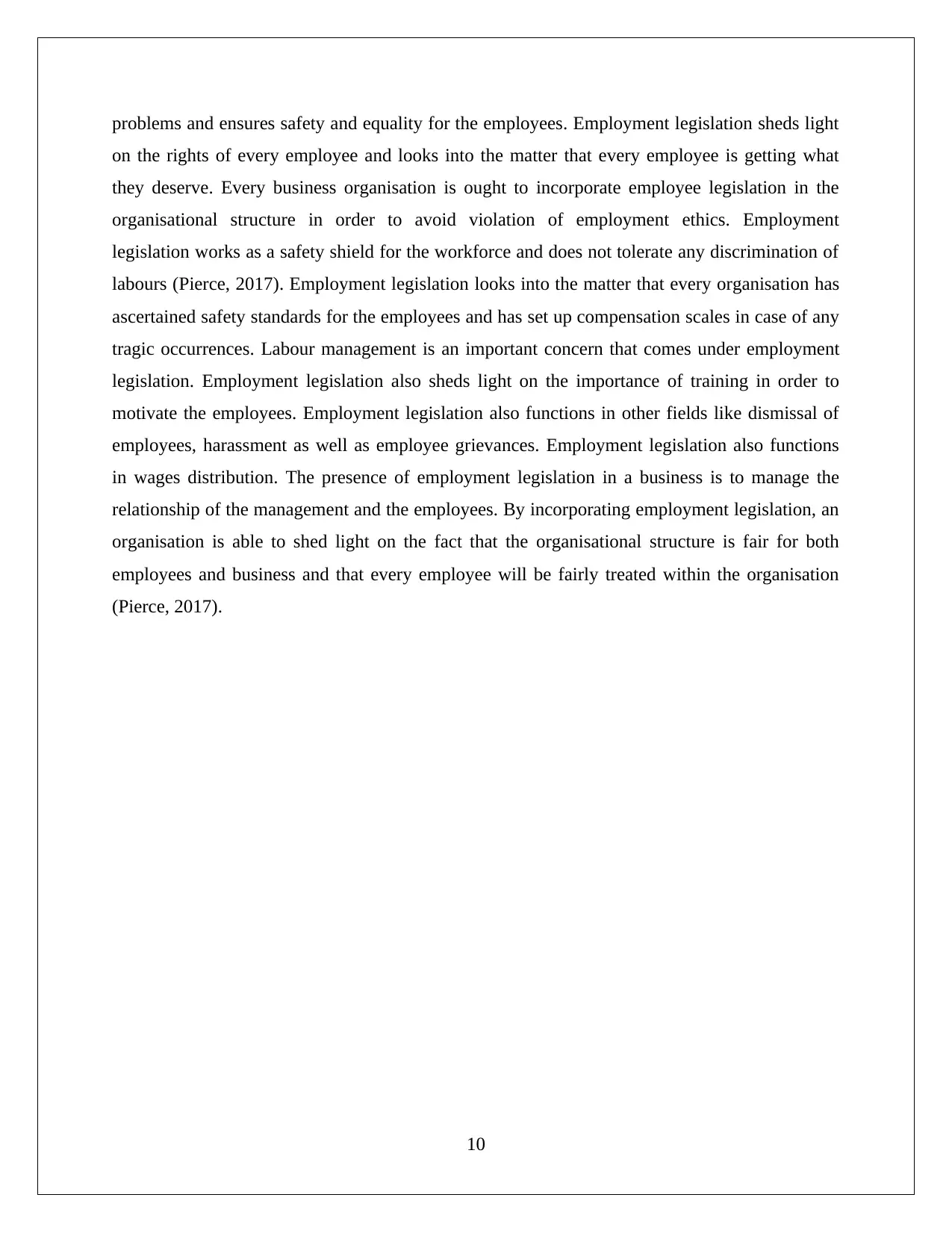
problems and ensures safety and equality for the employees. Employment legislation sheds light
on the rights of every employee and looks into the matter that every employee is getting what
they deserve. Every business organisation is ought to incorporate employee legislation in the
organisational structure in order to avoid violation of employment ethics. Employment
legislation works as a safety shield for the workforce and does not tolerate any discrimination of
labours (Pierce, 2017). Employment legislation looks into the matter that every organisation has
ascertained safety standards for the employees and has set up compensation scales in case of any
tragic occurrences. Labour management is an important concern that comes under employment
legislation. Employment legislation also sheds light on the importance of training in order to
motivate the employees. Employment legislation also functions in other fields like dismissal of
employees, harassment as well as employee grievances. Employment legislation also functions
in wages distribution. The presence of employment legislation in a business is to manage the
relationship of the management and the employees. By incorporating employment legislation, an
organisation is able to shed light on the fact that the organisational structure is fair for both
employees and business and that every employee will be fairly treated within the organisation
(Pierce, 2017).
10
on the rights of every employee and looks into the matter that every employee is getting what
they deserve. Every business organisation is ought to incorporate employee legislation in the
organisational structure in order to avoid violation of employment ethics. Employment
legislation works as a safety shield for the workforce and does not tolerate any discrimination of
labours (Pierce, 2017). Employment legislation looks into the matter that every organisation has
ascertained safety standards for the employees and has set up compensation scales in case of any
tragic occurrences. Labour management is an important concern that comes under employment
legislation. Employment legislation also sheds light on the importance of training in order to
motivate the employees. Employment legislation also functions in other fields like dismissal of
employees, harassment as well as employee grievances. Employment legislation also functions
in wages distribution. The presence of employment legislation in a business is to manage the
relationship of the management and the employees. By incorporating employment legislation, an
organisation is able to shed light on the fact that the organisational structure is fair for both
employees and business and that every employee will be fairly treated within the organisation
(Pierce, 2017).
10
Paraphrase This Document
Need a fresh take? Get an instant paraphrase of this document with our AI Paraphraser
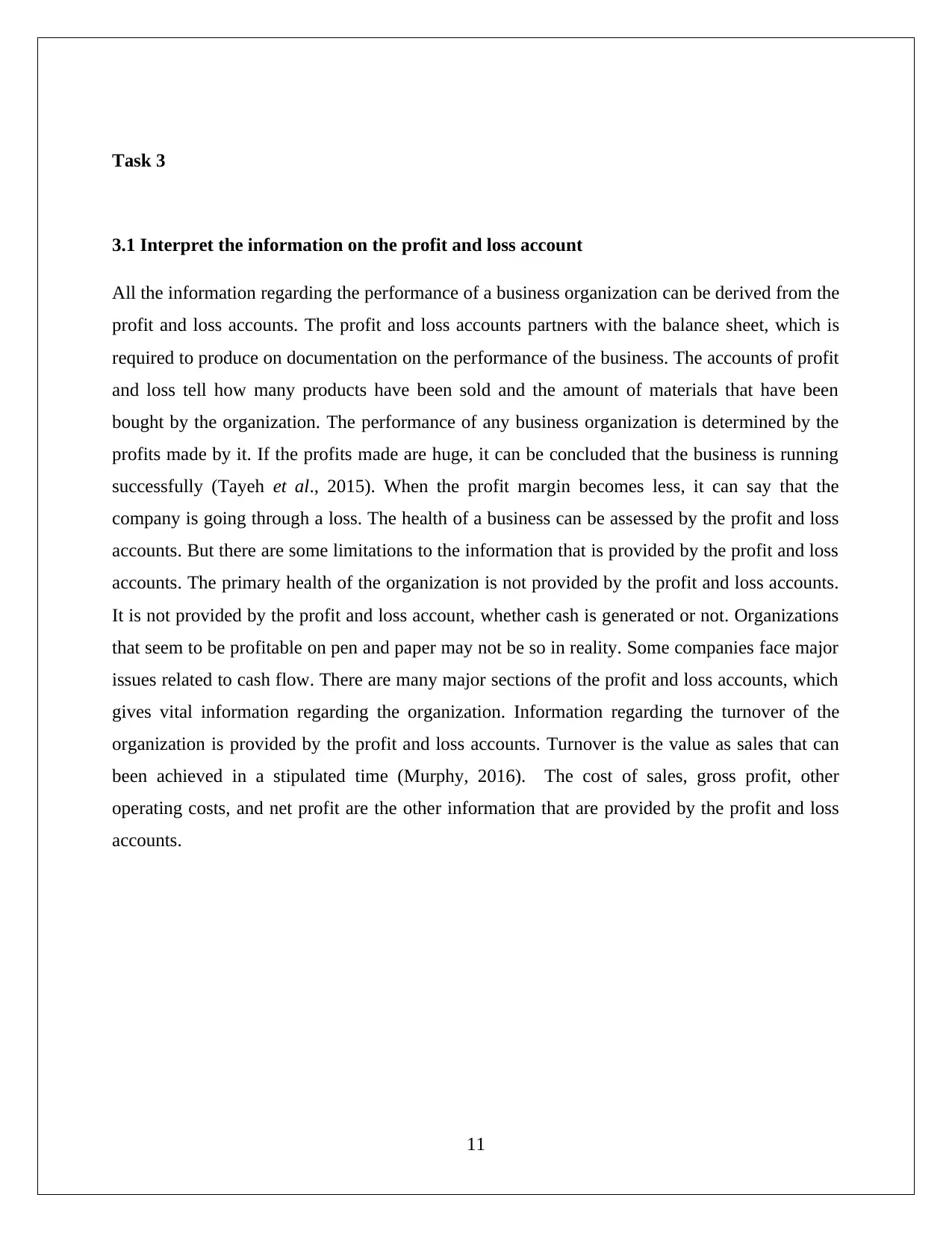
Task 3
3.1 Interpret the information on the profit and loss account
All the information regarding the performance of a business organization can be derived from the
profit and loss accounts. The profit and loss accounts partners with the balance sheet, which is
required to produce on documentation on the performance of the business. The accounts of profit
and loss tell how many products have been sold and the amount of materials that have been
bought by the organization. The performance of any business organization is determined by the
profits made by it. If the profits made are huge, it can be concluded that the business is running
successfully (Tayeh et al., 2015). When the profit margin becomes less, it can say that the
company is going through a loss. The health of a business can be assessed by the profit and loss
accounts. But there are some limitations to the information that is provided by the profit and loss
accounts. The primary health of the organization is not provided by the profit and loss accounts.
It is not provided by the profit and loss account, whether cash is generated or not. Organizations
that seem to be profitable on pen and paper may not be so in reality. Some companies face major
issues related to cash flow. There are many major sections of the profit and loss accounts, which
gives vital information regarding the organization. Information regarding the turnover of the
organization is provided by the profit and loss accounts. Turnover is the value as sales that can
been achieved in a stipulated time (Murphy, 2016). The cost of sales, gross profit, other
operating costs, and net profit are the other information that are provided by the profit and loss
accounts.
11
3.1 Interpret the information on the profit and loss account
All the information regarding the performance of a business organization can be derived from the
profit and loss accounts. The profit and loss accounts partners with the balance sheet, which is
required to produce on documentation on the performance of the business. The accounts of profit
and loss tell how many products have been sold and the amount of materials that have been
bought by the organization. The performance of any business organization is determined by the
profits made by it. If the profits made are huge, it can be concluded that the business is running
successfully (Tayeh et al., 2015). When the profit margin becomes less, it can say that the
company is going through a loss. The health of a business can be assessed by the profit and loss
accounts. But there are some limitations to the information that is provided by the profit and loss
accounts. The primary health of the organization is not provided by the profit and loss accounts.
It is not provided by the profit and loss account, whether cash is generated or not. Organizations
that seem to be profitable on pen and paper may not be so in reality. Some companies face major
issues related to cash flow. There are many major sections of the profit and loss accounts, which
gives vital information regarding the organization. Information regarding the turnover of the
organization is provided by the profit and loss accounts. Turnover is the value as sales that can
been achieved in a stipulated time (Murphy, 2016). The cost of sales, gross profit, other
operating costs, and net profit are the other information that are provided by the profit and loss
accounts.
11
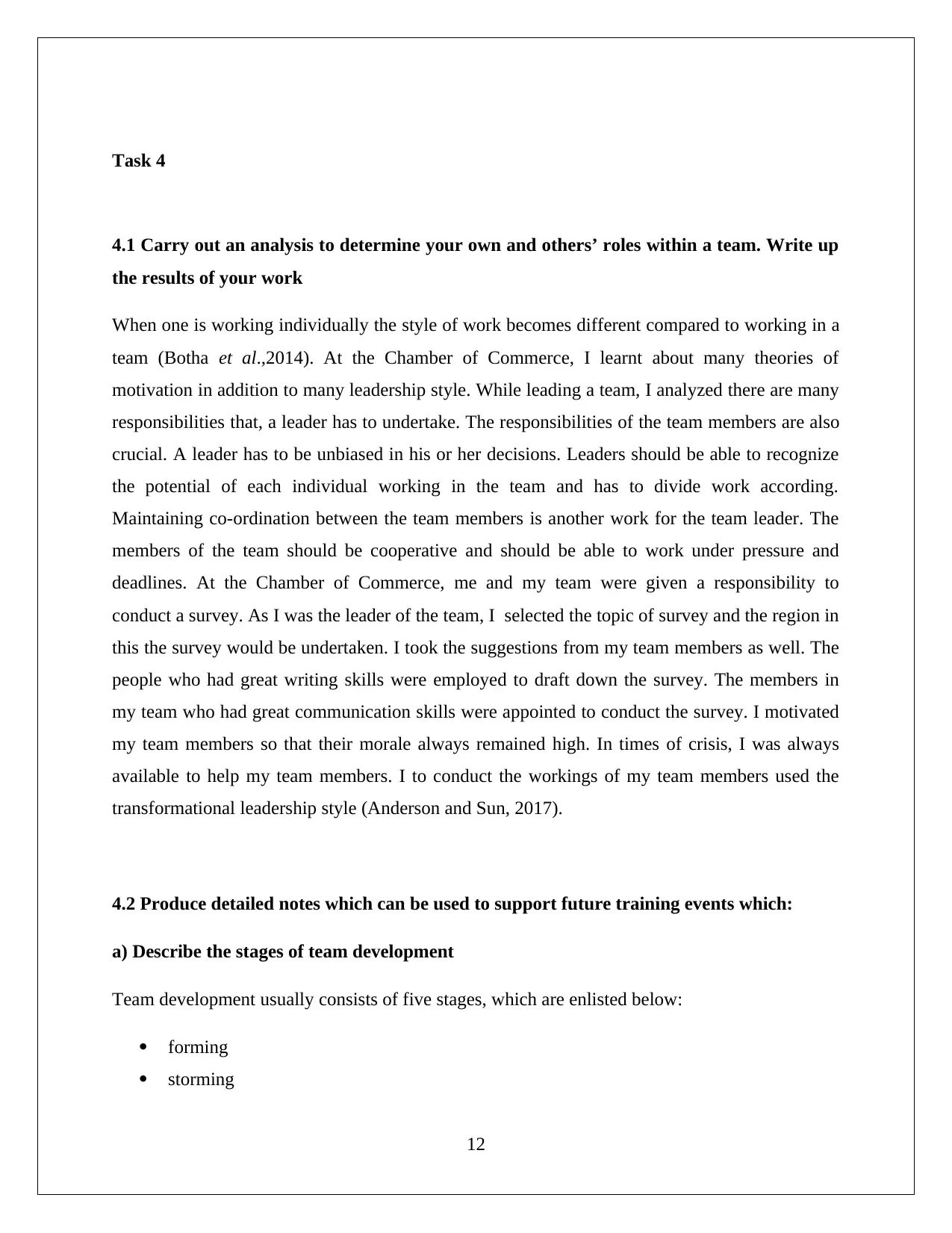
Task 4
4.1 Carry out an analysis to determine your own and others’ roles within a team. Write up
the results of your work
When one is working individually the style of work becomes different compared to working in a
team (Botha et al.,2014). At the Chamber of Commerce, I learnt about many theories of
motivation in addition to many leadership style. While leading a team, I analyzed there are many
responsibilities that, a leader has to undertake. The responsibilities of the team members are also
crucial. A leader has to be unbiased in his or her decisions. Leaders should be able to recognize
the potential of each individual working in the team and has to divide work according.
Maintaining co-ordination between the team members is another work for the team leader. The
members of the team should be cooperative and should be able to work under pressure and
deadlines. At the Chamber of Commerce, me and my team were given a responsibility to
conduct a survey. As I was the leader of the team, I selected the topic of survey and the region in
this the survey would be undertaken. I took the suggestions from my team members as well. The
people who had great writing skills were employed to draft down the survey. The members in
my team who had great communication skills were appointed to conduct the survey. I motivated
my team members so that their morale always remained high. In times of crisis, I was always
available to help my team members. I to conduct the workings of my team members used the
transformational leadership style (Anderson and Sun, 2017).
4.2 Produce detailed notes which can be used to support future training events which:
a) Describe the stages of team development
Team development usually consists of five stages, which are enlisted below:
forming
storming
12
4.1 Carry out an analysis to determine your own and others’ roles within a team. Write up
the results of your work
When one is working individually the style of work becomes different compared to working in a
team (Botha et al.,2014). At the Chamber of Commerce, I learnt about many theories of
motivation in addition to many leadership style. While leading a team, I analyzed there are many
responsibilities that, a leader has to undertake. The responsibilities of the team members are also
crucial. A leader has to be unbiased in his or her decisions. Leaders should be able to recognize
the potential of each individual working in the team and has to divide work according.
Maintaining co-ordination between the team members is another work for the team leader. The
members of the team should be cooperative and should be able to work under pressure and
deadlines. At the Chamber of Commerce, me and my team were given a responsibility to
conduct a survey. As I was the leader of the team, I selected the topic of survey and the region in
this the survey would be undertaken. I took the suggestions from my team members as well. The
people who had great writing skills were employed to draft down the survey. The members in
my team who had great communication skills were appointed to conduct the survey. I motivated
my team members so that their morale always remained high. In times of crisis, I was always
available to help my team members. I to conduct the workings of my team members used the
transformational leadership style (Anderson and Sun, 2017).
4.2 Produce detailed notes which can be used to support future training events which:
a) Describe the stages of team development
Team development usually consists of five stages, which are enlisted below:
forming
storming
12
⊘ This is a preview!⊘
Do you want full access?
Subscribe today to unlock all pages.

Trusted by 1+ million students worldwide
1 out of 20
Related Documents
Your All-in-One AI-Powered Toolkit for Academic Success.
+13062052269
info@desklib.com
Available 24*7 on WhatsApp / Email
![[object Object]](/_next/static/media/star-bottom.7253800d.svg)
Unlock your academic potential
Copyright © 2020–2025 A2Z Services. All Rights Reserved. Developed and managed by ZUCOL.





